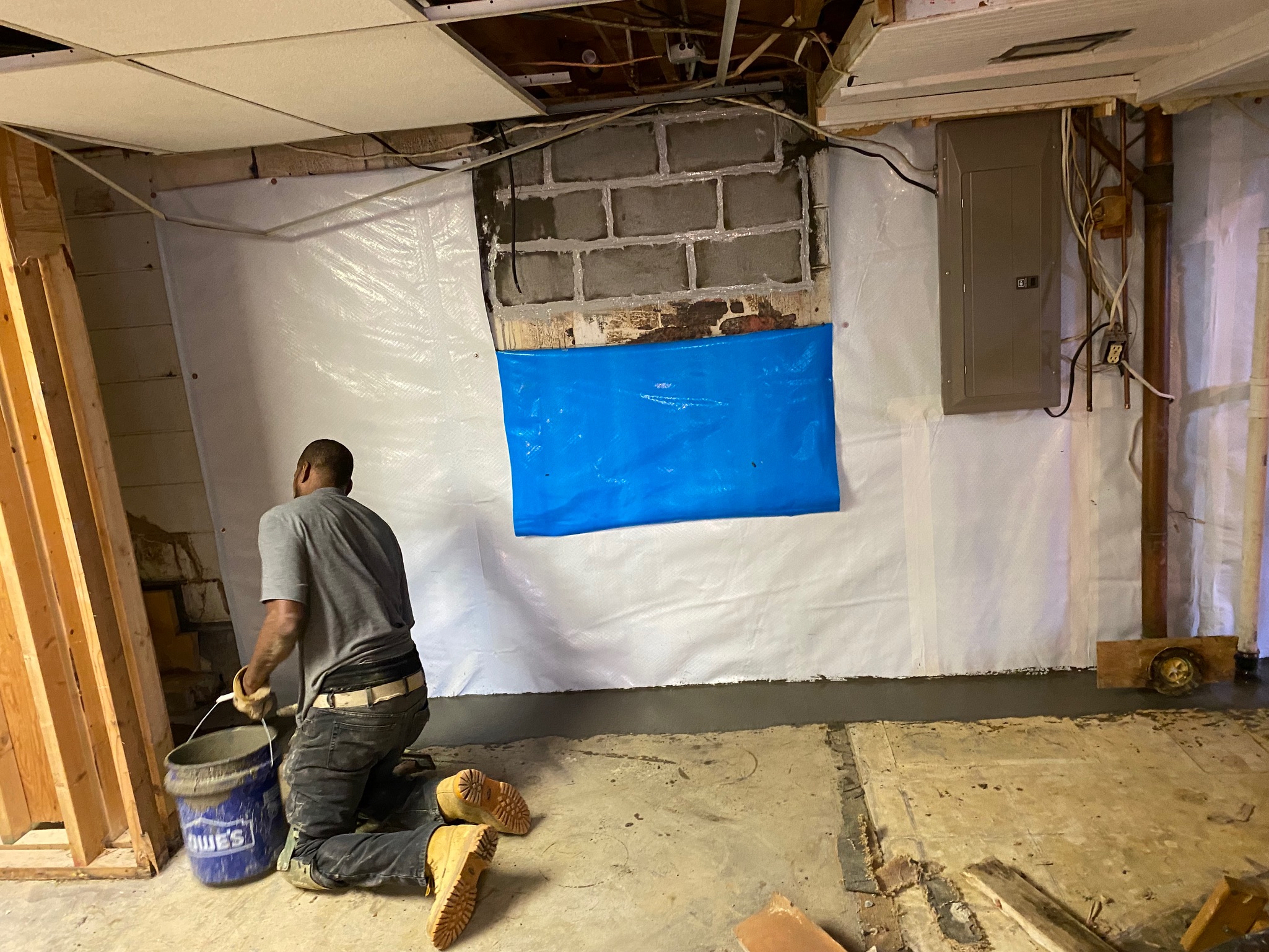
Ever had a soggy basement? It’s not just about waterproofing the interior. Your yard plays a crucial role too. Effective landscape design can do wonders in keeping your basement dry and damage-free. It’s all about directing water away from your house, but how exactly do you do that? Let’s explore some landscaping tips that can help you accomplish this task. Stick around, there’s a lot you might want to consider.
Key Takeaways
- Implement effective drainage strategies such as landscape slopes, drainage pipes, waterproof membranes, and sump pumps to manage water flow.
- Ensure proper grading and balanced soil composition for optimal water absorption and drainage, reducing the risk of basement flooding.
- Install drainage solutions like French drains and retaining walls to manage subsurface water and soil pressure, protecting your home’s foundation.
- Create a rain garden and use native landscaping to absorb rainwater, reduce runoff, and enhance soil drainage while improving your yard’s aesthetics.
- Maintain your yard regularly, including proper grading, mulching, soil aeration, and erosion control measures to ensure effective drainage and landscape health.
Understanding Water Flow
A great number of homeowners fail to realize the importance of understanding water flow for maintaining a dry basement. You might be wondering, why is this so crucial? Well, it’s because the water that seeps into your basement often originates from sources around your property.
Think about it, where does water usually come from? It could be rain, melted snow, or even a sprinkler system. These water sources, if not managed properly, can cause a real headache. Now, you’re not just dealing with a soggy yard, but a wet basement too.
Understanding drainage patterns is equally important. These patterns dictate the path that water takes once it hits the ground. For example, if your yard slopes towards your house, guess where that water’s going to end up? That’s right, in your basement.
The Importance of Grading
Don’t underestimate the role of proper grading in your landscaping efforts.
It’s essential to first grasp the basics of grading, then understand how it can help control water flow around your home.
Understanding Grading Basics
Grasping the fundamentals of grading can significantly impact the dryness of your basement. It’s all about understanding soil composition and slope measurement, two components that play a big role in how water interacts with your land.
Knowing your soil composition matters because different soils have varying capacities to absorb and drain water. For instance, sandy soil drains faster than clay soil. If you’re not sure about your soil type, you can get it tested.
Slope measurement, on the other hand, determines how water will flow across your property. Ideally, you want a gentle slope that directs water away from your home.
Here’s a quick overview:
| Aspect | Sandy Soil | Clay Soil |
|---|---|---|
| Water Absorption | High | Low |
| Water Drainage | Fast | Slow |
| Slope | Effect |
|---|---|
| Flat | Water pools |
| Steep | Water runs off quickly |
| Gentle | Water drains away effectively |
In the end, understanding grading basics isn’t just about keeping your basement dry. It’s about maintaining the overall health of your property. So, don’t underestimate the power of a good grade!
Grading for Water Control
Your home’s landscape plays a pivotal role in controlling water flow and maintaining a dry basement. It’s all about grading for water control, a task that might seem daunting, but it’s simpler than you’d think.
Grading involves modifying the slope and elevation of your yard to direct water away from your home. Here, drainage techniques and soil composition are key factors. Working with the natural lay of your land, you’ll adjust terrain to create a slope that ushers water away from your home’s foundation.
Soil composition is equally important. Different soils have varying abilities to absorb and drain water. For instance, sandy soil drains quickly, but clay soil retains water. The ideal, then, is a balance that can both absorb rainwater and direct excess away.
Remember, the goal isn’t just a dry basement but also preventing soil erosion and preserving your yard’s aesthetic appeal. In the end, effective grading for water control is a practical solution that marries functionality with design.
Moving on, let’s delve into more specific preventative grading techniques. But that’s a topic for next time, so stay tuned!
Preventative Grading Techniques
Understanding preventative grading techniques is crucial for keeping your basement dry. It’s all about directing water away from your home’s foundation. The first thing you’ll need to do is get a slope measurement. This helps you understand the current lay of your land and where water is likely to flow.
Next, you’ll want to use appropriate drainage materials. These could range from gravel and sand to drain tiles and French drains. The right choice depends on your specific situation.
Finally, make the necessary adjustments to your landscape to create a gentle slope away from your house. This doesn’t mean you need a hill in your backyard, but a subtle incline can make a big difference.
| Step | Task | Key Point |
|---|---|---|
| 1 | Slope Measurement | Understand your land’s lay |
| 2 | Choose Drainage Materials | Gravel, sand, drain tiles, or French drains |
| 3 | Adjust Landscape | Create a gentle slope away from your house |
Installing a French Drain
When it comes to keeping your basement dry, a French drain can be a real game-changer. This type of drainage system is a trench filled with gravel or rock, containing a perforated pipe that diverts water away from your home. French drain installation isn’t as daunting as it sounds, and it’s an effective solution for managing water flow around your property.
Different drainage system types serve various purposes, but a French drain specifically tackles sub-surface water. That’s the stuff that can seep into your basement and cause all sorts of trouble. You’ll want to install it in areas where water tends to accumulate. You can even use it to relieve the pressure that excess water places on your home’s foundation.
To install a French drain, start by digging a trench along the outside of your footer. The trench should slope away from your house, allowing water to flow freely.
Then, place a layer of gravel in the trench, lay down the perforated pipe, and cover it with more gravel. Properly installed, a French drain can be your basement’s best defense against unwanted moisture.
Choosing the Right Plants
Picking the right plants can significantly impact your landscaping and basement dryness. You should consider native plants, as they’re naturally adapted to your area’s climate and soil conditions, thus promoting soil health. These plants tend to have deep roots which help absorb water, reducing the amount of moisture that could potentially seep into your basement.
Opt for drought-resistant varieties too. They require less watering which means less chance of water accumulating near your foundation.
However, don’t disregard moisture-loving plants completely. They can also play a role in your landscape design when placed strategically. For instance, plant them in areas where water tends to collect after a rain. They’ll soak up the excess water, keeping it away from your home.
Seasonal considerations are important as well. Some plants might be great at absorbing water during their growing season but once they shed their leaves, they’re not as effective.
Therefore, aim for a mix of evergreen and deciduous plants to ensure year-round protection.
Benefits of Rain Gardens
Now, let’s talk about the perks of rain gardens.
They’re more than just a beautiful addition to your yard; they can serve as an effective drainage solution too.
If you’re keen to keep your basement dry, understanding the basics and implementation of rain gardens could be a game changer.
Rain Garden Basics
You might be wondering, “What is a rain garden and how can it benefit me?” A rain garden is more than just a visually appealing aspect of your landscaping. It’s a clever, functional addition that can help keep your basement dry.
A rain garden is a small, shallow depression in your yard that collects and absorbs rainwater, primarily from your roof. The rain garden design is meant to act like a sponge, soaking up the rainwater and slowly releasing it back into the ground. This not only prevents water from pooling around your home’s foundation but also reduces runoff that can erode your soil.
The real heroes of a rain garden are native plants. They’re well adapted to local conditions and can handle both heavy rains and dry periods. These plants have deep roots that create channels in the soil, allowing water to seep down more effectively.
They’re also great at filtering rainwater, removing pollutants before they reach the groundwater.
There you have it! A rain garden isn’t only a practical way to manage rainwater but also an opportunity to showcase native plants, adding natural beauty to your landscape.
Implementing Effective Drainage
Building on the concept of rain gardens, let’s explore how these landscaping features aid in implementing effective drainage. Rain gardens offer a natural and aesthetically pleasing solution to manage surface runoff while also enhancing your landscape’s overall appearance. They utilize soil permeability, a key factor in managing water flow, to slow down runoff, promote infiltration, and control erosion.
Effective drainage solutions aren’t limited to rain gardens. Consider these additional strategies:
- Landscape slopes and drainage pipes: Directing water away from your home is crucial for foundation protection. A well-planned landscape slope, combined with strategically placed drainage pipes, can divert water effectively.
- Water barriers and sump pumps: Waterproof membranes act as water barriers around your home, guarding against unwanted moisture. Sump pumps, installed in the lowest part of your basement, work in tandem with these barriers to pump water away.
- Erosion control: Ground coverings and retaining walls can prevent soil displacement. They’re especially important in areas prone to heavy rains or melting snow.
Incorporating Retaining Walls
Three out of five homeowners find incorporating retaining walls an effective strategy to prevent basement dampness. You might wonder why? Well, these walls serve as barriers against soil pressure and manage water flow, preventing it from seeping into your basement.
Choosing the right retaining wall materials plays a significant role. You can opt for concrete blocks, poured concrete, stone, bricks, or wood. Each has its pros and cons, so it’s crucial to select a material that suits your landscape’s aesthetics, budget, and needs.
Wall drainage solutions are equally vital. Without appropriate drainage, water pressure can build, compromising your retaining wall’s integrity and leading to potential basement leaks. You can implement weep holes or use gravel and fabric to facilitate proper drainage.
Keep in mind that the effectiveness of retaining walls is also influenced by their design. Ensure that they’re installed at a correct angle and height.
Additionally, make sure they’re far enough from your house to prevent any potential damage while still providing effective protection.
Regular Yard Maintenance Tips
Regular yard maintenance can make a significant difference in keeping your basement dry. It’s not just about mowing the lawn and keeping the garden tidy; you need to ensure your yard is properly graded and the soil aerated to prevent water from pooling and seeping into your basement.
Here are three key maintenance tasks you should focus on:
- Mulching: Mulching benefits your yard in several ways. It helps retain soil moisture during dry periods, prevents weed growth, and improves soil health, allowing water to drain properly and reducing the chances of basement leaks.
- Soil Aeration: Over time, soil can become compacted, leading to poor drainage. Aeration creates small holes in your lawn, allowing water to penetrate deeper, preventing runoff and pooling.
- Proper Grading: Ensure your yard slopes away from your home. This directs water away from your foundation, reducing the risk of it finding its way into your basement.
Frequently Asked Questions
What Materials Are Best for Creating a Water-Resistant Basement?
To create a water-resistant basement, you’ll want to use waterproof membranes and reliable drainage systems.
Waterproof membranes are a great barrier against water seepage; you apply them to your basement’s exterior walls.
Drainage systems, on the other hand, divert water away from your foundation. They’re crucial in areas prone to heavy rainfall.
Can Landscaping Changes Affect My Homes Foundation?
Yes, landscaping changes can significantly affect your home’s foundation.
By creating effective drainage solutions, you’re guiding water away from your house, protecting your foundation.
The soil composition also matters. Sandy soil drains quickly but may not support the foundation as well as clay, which drains poorly but provides more support.
Thus, it’s important to strike a balance.
Consider consulting with a professional for advice tailored to your specific situation.
How Often Should I Inspect My Yard for Potential Water Issues?
You should inspect your yard for potential water issues every season.
Look for problems with yard drainage, like pooling water or soggy areas. Check your soil grading too. It should slope away from your home, preventing water from seeping towards your foundation.
If you notice any issues, act quickly. Regular checks and prompt action can protect your home from water damage.
Ignoring potential issues won’t make them disappear, it’ll just lead to bigger problems down the line.
Are There Any Specific Landscaping Designs That Help in Basement Drying?
Absolutely! Incorporating effective drainage systems in your landscaping design can significantly help keep your basement dry.
Consider slopes that guide water away from your home.
Also, your plant selection matters. Choose plants that soak up a lot of water and place them strategically in your yard.
They’ll absorb excess moisture and help prevent it from reaching your basement.
Does Homeowners Insurance Typically Cover Basement Water Damage?
Typically, homeowners insurance policies don’t cover basement water damage caused by outside flooding.
You’ll need separate flood coverage for that.
However, if an internal issue, like a burst pipe, causes the damage, your policy may cover it.
It’s crucial to thoroughly read your policy and understand what’s covered.
If you’re unsure, reach out to your insurance provider for clarification.
Conclusion
So, you’ve got the tools to keep your basement dry through landscaping. Just remember this: grade your yard, install a French drain, pick the right plants, and consider a rain garden. Don’t forget about retaining walls or regular maintenance. It might seem like a lot, but with these tips, you’re on your way to a drier basement and a healthier landscape. Start today, and you’ll be saying goodbye to that soggy basement in no time.

Seal-tite Basement Waterproofing Co. is a full service basement environment contractor. We carry an A+ Better Business Bureau rating. We repaired over 40,000 homes and structures in Virginia, West Virginia, Tennessee, and North Carolina. We are fully insured and licensed. We have worked in all types of locations, including residential and commercial locations, government agencies, colleges, hospitals, churches, and condo associations.
Seal-tite® offers a lifetime transferable warranty. We carry a Class A Contractor’s License and we are fully insured. Our satisfied customers range from government agencies to businesses, hospitals, colleges, churches, and thousands of homeowners. Your home is probably the single largest investment you will make in your lifetime. Don’t wait, call Seal-tite® to help make your home dry, safe and livable.

